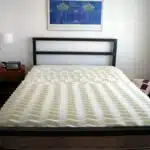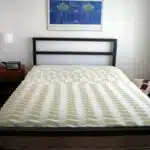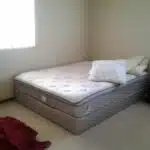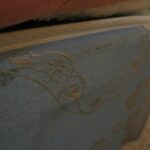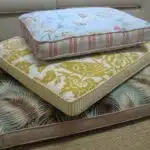As a home organization expert, I have encountered many homeowners who struggle with keeping their sheets on their beds. It is not only frustrating but also time-consuming to constantly adjust the sheets every morning. This problem affects people of all ages and can be caused by various factors such as bed type, sheet size, and sleeping habits. In this article, we will discuss ten strategies that will help you keep your sheets on your bed and provide you with a peaceful night’s sleep.
One of the most common causes of sheets slipping off the bed is when the fitted sheet is not properly secured. This could be due to an ill-fitting sheet or a mattress that is too thin or too thick for the sheet. Another factor could be how you move in your sleep, which can cause the sheets to come undone. All these factors may make it difficult to keep your sheets on your bed throughout the night. However, with our ten strategies, we will give you practical solutions that will assist you in keeping your sheets secure so that you can sleep soundly without any disturbances.
Properly Fitting Your Sheets
Properly fitting sheets are essential to ensuring a comfortable and restful night’s sleep. Sheets that are too small will bunch up and pop off the corners, while oversized sheets can easily become wrinkled and bunched. To achieve proper sheet fit, start by measuring your mattress’s length, width, and height. It is also important to ensure that you have the correct size pillowcases for your pillows.
Once you have measured your mattress dimensions, it is time to select the appropriate sheet size. Keep in mind that sheet sizes may vary between manufacturers, so always refer to the specific measurements provided on the packaging. If you have an extra-thick mattress or a pillow top, consider purchasing deep-pocket sheets that provide additional room for a snug fit.
Properly fitting sheets not only improve your sleeping experience but also contribute to the overall appearance of your bedroom. By selecting the correct sheet size and following these tips for achieving a precise fit, you can create a cozy and stylish oasis for restful nights ahead. In the next section, we will discuss how to choose the right sheet size for your bed based on common mattress types and dimensions.
Choosing The Right Sheet Size For Your Bed
- It is important to consider both sheet measurements and bed dimensions when selecting the right sheets for your bed.
- Sheet measurements must be taken into account to ensure that the sheets are large enough to cover the mattress and its edges.
- Bed dimensions should be taken into account to ensure that the sheets are not too large, which can cause the sheets to bunch up or slip off the bed during the night.
- To determine the right size of sheets for your bed, use the mattress manufacturer’s size guidelines and measure your bed accordingly.
Sheet Measurements
When it comes to choosing the right sheet size for your bed, sheet measurements are crucial. It is important to know the exact dimensions of your mattress in order to purchase sheets that fit properly. A fitted sheet that is too small will constantly slip off the corners of your mattress, while a fitted sheet that is too big will bunch up and create uncomfortable lumps.
To ensure that you have the correct sheet measurements, measure both the length and width of your mattress, as well as its height. This will allow you to choose sheets that are deep enough to fit snugly around your mattress. Additionally, consider investing in high-quality sheets made from durable fabrics such as Egyptian cotton or bamboo. These fabrics not only feel soft and luxurious against your skin, but they also hold up well over time with proper care.
In terms of sheet care, always follow the manufacturer’s instructions for washing and drying your sheets. Avoid using hot water or harsh detergents, which can damage the fabric and cause it to shrink or pill. Instead, opt for cool or warm water and gentle detergents specifically designed for delicate fabrics like cotton or linen. With these tips in mind, you can keep your sheets looking and feeling great for years to come.
Bed Dimensions
When it comes to choosing the right sheet size for your bed, one crucial factor to consider is bed dimensions. Bed size compatibility is essential in ensuring that your sheets fit properly and comfortably. Mattress size comparison will help you determine the exact measurements of your mattress, which will then guide you in purchasing the correct sheet size.
Before purchasing sheets, measure both the length and width of your mattress, as well as its height. This information will allow you to choose sheets that are deep enough to fit snugly around your mattress. It is important to note that mattress sizes may vary across different brands and models, so always double-check the measurements before making a purchase.
Additionally, when purchasing sheets, consider investing in high-quality fabrics such as Egyptian cotton or bamboo. These materials not only feel soft and luxurious against your skin but also hold up well over time with proper care. By taking into account bed dimensions and investing in quality fabrics, you can ensure a comfortable and restful night’s sleep for years to come.
Using Sheet Clips Or Fasteners
Now that you’ve chosen the right sheet size for your bed, it’s time to ensure that they stay in place throughout the night. One way of doing this is by using sheet clips or fasteners. These are small tools that attach to the corners of your sheets and keep them in place.
Sheet clips come in a variety of shapes and sizes, but they all serve the same purpose: to prevent your sheets from slipping off the bed. They’re easy to use and can be purchased at most home goods stores. Simply attach them to each corner of your fitted sheet and adjust as necessary to create a secure fit.
Sheet fasteners work similarly to sheet clips, but instead of attaching to the corners of your fitted sheet, they wrap around the entire mattress. This creates an even more secure hold on your sheets and prevents any movement throughout the night. While they may take a bit more effort to set up than sheet clips, they provide added peace of mind for those who tend to move around a lot in their sleep.
By incorporating sheet clips or fasteners into your bedding routine, you’ll no longer have to worry about waking up with tangled or bunched-up sheets. These simple tools provide an easy solution for keeping your bedding in place all night long, ensuring a comfortable and restful sleep experience. In our next section, we’ll discuss how tucking in your sheets properly can also help prevent slipping and sliding during sleep.
Tucking In Your Sheets Properly
When tucking in the sheets for a bed, it is important to ensure that the sides are tucked in firmly. This will prevent the sheet from slipping off the bed and keep the bed looking neat. Additionally, it is important to make sure that the corners of the sheets are tightly tucked in to keep them from unravelling over time. Doing this will ensure that the sheets are secure and provide a neat look to the bed.
Tucking In Sides
One of the most frustrating problems that people face when making their bed is keeping the sheets in place. It’s not uncommon to wake up in the morning and find that your sheets have come undone, leaving you with a tangled mess. Fortunately, there are many strategies you can use to keep your sheets on the bed. One of the most effective methods is tucking in the sides.
To start, begin by folding your sheet over at the top of your bed so that it hangs evenly on both sides. Then, lift up one side of your mattress and tuck in the sheet tightly along the edge. Repeat this process on the other side of your bed to ensure a secure fit. If you’re having trouble keeping the sheet tucked in, consider using sheet clips or elastic straps to hold it in place.
Another helpful tip for keeping sheets from slipping off is to add an extra layer of bedding between your mattress and fitted sheet. This will create a cushioning effect that helps hold everything in place. Additionally, make sure that you’re using sheets that fit properly on your bed. If they’re too small or too large, they won’t stay put no matter how tightly you tuck them in.
In conclusion, proper bed sheet folding and tucking techniques are essential for maintaining a neat and tidy appearance in any bedroom. By following these simple strategies for tucking in your sheets properly, you can enjoy a comfortable and restful night’s sleep without having to worry about constantly adjusting them throughout the night. With a little practice and patience, anyone can master these skills and achieve a perfectly made bed every time!
Tucking In Corners
Properly tucking in your sheets is an essential part of creating a neat and organized bedroom. In addition to keeping the sheets in place, it also creates a polished and inviting atmosphere. While tucking in the sides of your sheets is a great starting point, there are also corner-tucking alternatives that can be just as effective.
One creative sheet folding technique involves tucking in the corners. To do this, start by laying your flat sheet over your fitted sheet with the top edge even with the top of your mattress. Then, take one corner of the sheet and lift it up so that it forms a triangle. Tuck this triangle under the mattress at the foot of your bed. Repeat this process on the opposite side to create two triangular flaps under each corner. This method not only keeps everything in place but also adds an extra layer of warmth to your bedding.
Another alternative to traditional sheet tucking is using a duvet cover instead of a flat sheet. Simply insert your comforter into a duvet cover and secure it with buttons or ties at each corner. This not only keeps everything in place but also makes changing bedding easier since you only have to wash the duvet cover instead of all layers of bedding.
By incorporating these corner-tucking alternatives and creative sheet folding techniques into your bedding routine, you can achieve a perfectly made bed that stays tidy and comfortable throughout the night. With these tips, you can elevate your bedroom organization game and create a relaxing space for yourself or for guests.
Investing In A Fitted Sheet With Deep Pockets
As the saying goes, “a good night’s sleep starts with a well-made bed.” Investing in a fitted sheet with deep pockets can certainly contribute to this goal. The benefits of doing so are many, including a snug fit that keeps the sheet from slipping off or bunching up during sleep. This type of sheet also tends to be made of higher quality materials, which translates into greater durability and comfort.
Alternatives to investing in a fitted sheet with deep pockets include using sheet straps, clips, or suspenders to hold the corners in place. While these options may be effective for some people, they can also be cumbersome and time-consuming to use. Additionally, they may cause damage to the sheets over time by creating tension on the fabric.
Overall, investing in a fitted sheet with deep pockets is a wise choice for anyone looking to improve their sleeping experience. Not only does it provide practical benefits such as keeping the sheet securely in place, but it also adds an element of aesthetic appeal to the bed. In the next section, we’ll look at another way to enhance your bedding setup: using a mattress topper or pad.
Using A Mattress Topper Or Pad
- Mattress toppers and pads come in a variety of types, from basic foam toppers to more advanced memory foam and latex options.
- A mattress topper or pad can provide many benefits, such as improved breathability, additional support, and improved comfort.
- The thickness of the mattress topper can also be adjusted to accommodate different sleepers and sleeping positions.
- It is important to consider the type of mattress topper or pad that is best suited to meet the individual needs of the sleeper.
Mattress Topper Types
As a home organization expert, I understand the importance of using a mattress topper or pad to ensure a comfortable and restful sleep. When choosing the best mattress topper type, it is important to consider both the benefits and drawbacks of each option. Some common types include memory foam, latex, down feather, and wool.
Memory foam mattress toppers are known for their ability to contour to the body shape and provide pressure relief. However, they can retain heat which may not be desirable for hot sleepers. Latex mattress toppers offer similar benefits without the heat retention issue but can be more expensive. Down feather and wool mattress toppers provide natural insulation and breathability but may require frequent fluffing or shaking.
Ultimately, the best choice will depend on individual preferences and needs. Consider factors such as sleeping position, temperature preferences, allergies or sensitivities, and budget when choosing a mattress topper type. With proper research and consideration of benefits and drawbacks, finding the perfect mattress topper can greatly improve the quality of sleep.
Topper Benefits
When it comes to using a mattress topper or pad, there are numerous benefits that can greatly improve the quality of sleep. Firstly, mattress toppers provide an extra layer of cushioning that can help alleviate pressure points and reduce discomfort. This is especially beneficial for those who suffer from back pain or joint problems. Additionally, mattress toppers can prolong the life of a mattress by protecting it from wear and tear caused by body weight and movement.
In terms of types, different mattress topper materials offer unique benefits. For instance, memory foam toppers are known for their ability to contour to the body shape and provide customized support. This can help promote proper alignment of the spine and reduce tossing and turning during sleep. Latex toppers are also great options as they are naturally hypoallergenic and resistant to mold and dust mites. They also tend to have better breathability than memory foam, making them a good choice for hot sleepers.
Overall, the benefits of using a mattress topper or pad cannot be overstated. Not only do they provide added comfort and support, but they can also extend the lifespan of a mattress while improving overall sleep quality. When considering which type of mattress topper is best for your needs, be sure to take into account factors such as sleeping position, temperature preferences, allergies or sensitivities, and budget. By doing so, you’ll be well on your way towards achieving a more restful night’s sleep.
Trying Different Sheet Materials
If using a mattress topper or pad did not solve the issue of keeping sheets on your bed, perhaps it is time to consider trying different sheet materials. Sheet material comparison can help you determine which type of fabric best suits your needs and preferences. There are several factors to consider when choosing the right sheet material, including comfort, durability, breathability, and ease of maintenance.
Cotton sheets are a popular choice for their softness and breathability. They come in different thread counts, ranging from 200 to 1000 or more. However, cotton sheets may wrinkle easily, and they may shrink after washing. Silk sheets are luxurious and hypoallergenic but require special care when washing. Microfiber sheets are affordable and easy to maintain but may not be as breathable as cotton or silk.
Another option is linen sheets, which are durable and moisture-wicking, making them ideal for hot summer nights. However, linen sheets tend to be rougher than other fabrics and may require ironing. Flannel sheets are cozy and warm for cold winter nights but may be too heavy for year-round use. Overall, each sheet material has its pros and cons that should be considered before making a purchase.
Choosing the right sheet material can make a big difference in how well your sheets stay on your bed. By understanding the pros and cons of different fabrics, you can select the one that meets your needs best. In the next section, we will discuss another approach that can help you sleep better: changing your sleeping position.
Changing Your Sleeping Position
Studies have suggested that the position in which you sleep can affect your overall health, including your risk of developing certain conditions like sleep apnea and back pain. Therefore, it is important to consider your sleeping posture when looking for ways to improve your quality of sleep. One thing you can do is change up your sleeping position regularly, as this can alleviate pressure on certain areas of the body and promote better circulation. For instance, if you typically sleep on your back, try sleeping on your side instead.
Another factor to consider is the placement of your pillows. If you tend to wake up with a stiff neck or sore shoulders, it may be because your pillows are not providing adequate support. Make sure they are positioned in a way that keeps your head and neck aligned with the rest of your spine. Additionally, if you are a side sleeper, consider placing a pillow between your legs to help keep your hips properly aligned.
Overall, there are several small changes you can make to improve the quality of your sleep by changing up how you position yourself in bed. By experimenting with different sleeping postures and pillow placements, you can find what works best for you in terms of comfort and support. In the next section, we will discuss another strategy for keeping sheets on a bed: using a bed skirt.
Using A Bed Skirt
- A bed skirt is a decorative, rectangular piece of fabric that hangs from the sides and foot of a bed, often covering the box spring.
- Bed skirts come in a variety of fabrics, such as cotton, linen, and velvet, and a variety of colors, allowing for a tailored look to match any decor.
- Using a bed skirt may add a subtle layer of insulation, as well as conceal any unsightly items stored beneath the bed.
- Installing a bed skirt typically involves measuring the bed and cutting the fabric to the proper size.
- For convenience, bed skirts may be attached to the bed frame with clips or Velcro.
- Alternatively, bed skirts may be attached to the box spring or mattress with pins or ribbon, depending on the style of the skirt.
Types Of Bed Skirts
Bed skirts are a great addition to any bedroom decor. They not only add an element of style and sophistication, but they can also help keep your bed linens in place. When it comes to bed skirt styles, there are many options to choose from. The most common types include tailored, ruffled, pleated, and gathered.
Tailored bed skirts offer a clean and streamlined look that works well with modern or minimalist decor. Ruffled bed skirts add a touch of femininity and elegance to any bedroom. Pleated bed skirts are perfect for those who want a more structured look, while gathered bed skirts provide a softer and more romantic feel. If you’re looking for bed skirt alternatives, consider using a fitted sheet or fabric panels attached with Velcro.
When choosing the right bed skirt style for your room, it’s important to consider the overall theme and color scheme of your space. You’ll also want to think about the height of your mattress and box spring when selecting the length of your bed skirt. No matter what style you choose, a well-fitted bed skirt will add the finishing touch to your bedding ensemble and make your room look polished and put together.
Benefits Of A Bed Skirt
Now that we’ve discussed the different styles of bed skirts, let’s talk about the benefits of using one. Bed skirts serve more than just an aesthetic purpose; they also provide practical benefits that can make a difference in the look and feel of your bedroom.
One of the primary benefits of using a bed skirt is that it helps to keep dust and debris from accumulating under your bed. This is particularly important for people with allergies or respiratory issues, as these particles can exacerbate symptoms. Additionally, a bed skirt can help to protect your mattress and box spring from scratches and wear and tear.
Bed skirts also have a decorative function by adding an extra layer of visual interest to your bedding ensemble. They can be used to create a cohesive look by coordinating with other elements in the room such as curtains or throw pillows. Plus, they’re available in many styles and colors, making it easy to find one that complements your decor.
Overall, using a bed skirt is a practical and stylish choice for any bedroom. Whether you opt for a tailored, ruffled, pleated, or gathered style, you’ll enjoy the benefits of keeping your space clean and tidy while adding an extra touch of elegance to your decor.
Attaching A Bed Skirt
When it comes to using a bed skirt, there are several factors to consider. One important aspect is the attachment method. While some bed skirts come with elastic or Velcro attachments, others require a bit more effort to install properly. Fortunately, attaching a bed skirt is a straightforward process that can be accomplished with just a few basic tools.
One of the most popular ways to attach a bed skirt is with pins. To use this method, simply lay the bed skirt flat over your box spring and tuck the edges under the mattress. Then, use straight pins to secure the fabric in place along the top edge of the box spring. Be sure to space the pins evenly and use enough to hold the fabric securely without bunching or sagging.
Another option for attaching a bed skirt is with hook-and-loop tape. This method involves attaching strips of self-adhesive tape along both the top edge of the box spring and the back of the bed skirt. Once in place, simply press the two pieces together firmly to create a secure bond that will hold up over time.
In addition to these traditional bed skirt attachment methods, there are also alternative options available such as clip-on styles or wrap-around designs. No matter which method you choose, attaching a bed skirt is an important step in achieving a polished and put-together look for your bedroom decor. With so many styling ideas available, it’s easy to find one that suits your personal style and complements your bedding ensemble perfectly.
Creating A Tight Hospital Corner
Using a Bed Skirt is a great way to keep sheets on a bed, but it may not be enough for those who move around in their sleep. Creating a Tight Hospital Corner is another technique that can help keep your sheets in place. This technique involves tucking the sheet firmly under the mattress at the foot of the bed and then smoothly bringing it up to the head of the bed.
Bed making techniques are essential for keeping your bed looking neat and tidy. One of these techniques is using a fitted sheet, which has elastic edges that hug your mattress tightly, preventing it from slipping around. Another option is to use linen supplies such as sheet suspenders or grippers. These devices attach to each corner of your fitted sheet and hold them in place, even if you move around during sleep.
When it comes to organizing your linen supplies, make sure you have everything you need at hand. Keep extra sheets and pillowcases within easy reach so that you can change them when necessary. Store them in a cool and dry place so that they stay fresh longer. Make sure to label each item clearly so that you know exactly what is inside each container.
Using a sheet suspender is an effective way to keep sheets on a bed without having to worry about tucking them in constantly. These devices come in different shapes and sizes and can be adjusted according to the size of your mattress. They attach securely to the corners of your fitted sheet, ensuring that it stays put throughout the night. With this simple solution, you can enjoy a peaceful night’s rest without any disturbance from loose sheets!
Using A Sheet Suspenders
For those struggling with keeping their sheets on the bed, sheet suspenders can be a great solution. These handy devices work by clipping onto the corners of the sheet and securing them to the mattress, preventing any slipping or sliding during sleep. Sheet suspenders provide a reliable and easy-to-use option for keeping your sheets in place.
When using sheet suspenders, it is important to make sure they are properly adjusted to fit your specific mattress size. Most sheet suspender sets come with adjustable straps that can accommodate various bed sizes. Simply clip the suspenders onto each corner of the sheet and adjust the straps as needed to ensure a snug fit.
While sheet suspenders are an effective solution for many people, there are alternative options available as well. Some individuals may find that switching to a different sheet style, such as fitted sheets or deep-pocket sheets, works better for them. Ultimately, finding the right solution for keeping your sheets on the bed is a matter of personal preference and trial-and-error.
Transition into subsequent section: If you have tried using sheet suspenders and still find yourself struggling with keeping your sheets in place, don’t worry! There are other strategies you can try before giving up hope. One option is to experiment with different types of sheets to find what works best for you.
Trying A Different Sheet Style
Different sheet patterns can be a game-changer when it comes to keeping your sheets on the bed. Experimenting with colors and designs can not only add visual appeal to your bedroom but also make it easier to keep your sheets in place. Consider trying a fitted sheet with elastic bands that run diagonally across the corners, or a flat sheet with deep pockets that tuck under the mattress. These innovative designs create a snug fit that keeps your sheets from slipping off during the night.
When selecting new sheets, pay attention to the texture and material of the fabric. A sateen finish or jersey knit may feel soft and cozy against your skin, but they are notorious for their tendency to slide around on the mattress. Instead, opt for percale or linen fabrics that have a crisp texture and naturally grip onto the bed. Additionally, avoid using fabric softeners or dryer sheets, as they can coat the fibers and reduce their ability to hold onto the mattress.
Finally, don’t be afraid to mix and match different sheet styles until you find what works best for you. Try pairing a fitted sheet with deep pockets with a flat sheet that has diagonal elastic bands at each corner. Or choose contrasting colors for your top and bottom sheets so that you can easily spot any slippage throughout the night. With some experimentation and creativity, you’ll discover the perfect combination of different sheet patterns and techniques that will keep your bedding securely in place.
As we move forward into our next discussion about using non-slip mattress pads, keep in mind all of these useful strategies for keeping sheets secure on your bed. By incorporating different sheet patterns and experimenting with colors, you’ll not only improve functionality but also create an aesthetically pleasing environment in which to rest each night.
Using A Non-Slip Mattress Pad
If you’re tired of constantly adjusting your sheets every night, using a non-slip mattress pad might be the solution for you. These pads are designed to keep your sheets in place, preventing them from slipping and sliding off the bed. Not only does this save time and effort, but it also ensures a comfortable and peaceful sleep.
Benefits of using a non-slip mattress pad include added comfort, protection for your mattress, and reduced maintenance. These pads come in various materials such as foam, rubber or silicone which provides an extra layer of cushioning for your body while sleeping. Moreover, they can protect your mattress from wear and tear caused by constant movement of the sheets. Additionally, with the use of these pads, you will not have to frequently adjust or replace your sheets as they will remain securely in place.
There are different types of non-slip mattress pads available on the market. Some come with adhesive backing that sticks to the bottom surface of the mattress while others have straps that secure them in place. There are also those that have a textured surface that grips onto the sheets effectively. Depending on your preference and needs, you can choose one that suits you best.
Incorporating a non-slip mattress pad into your bedding setup is an affordable solution for keeping your sheets in place while providing additional benefits such as comfort and protection for your mattress. With various types available on the market today, finding one that fits both your budget and preferences should not be difficult. In order to maintain its effectiveness over time, make sure to follow manufacturer’s instructions when cleaning it regularly.
Transition: Now that we’ve discussed how to keep our sheets in place using a non-slip mattress pad let’s talk about another important aspect of bed maintenance-washing our sheets frequently.
Washing Your Sheets Frequently
As we discussed in the previous section, using a non-slip mattress pad can be an effective solution for keeping sheets on a bed. However, another important factor to consider is the frequency at which you launder your sheets. Not only does washing your sheets regularly ensure they are clean and fresh, but it can also help to maintain their shape and prevent them from slipping off the bed.
When it comes to laundering frequency, it is generally recommended that you wash your sheets at least once every two weeks. This will help to remove any dirt or sweat that has accumulated on the fabric, which can cause it to become less grippy over time. Of course, if you have pets or suffer from allergies, you may want to wash your sheets more frequently.
Another important consideration when it comes to keeping sheets on a bed is how you dry them. While air-drying can be gentle on the fabric and help to preserve its texture and grip, some people prefer the convenience of using a dryer. If you choose to use a dryer, be sure to select a low heat setting and avoid overloading the machine. You may also want to consider using wool dryer balls or tennis balls in the dryer cycle, as these can help to fluff up the fabric and prevent wrinkles.
In summary, when it comes to keeping sheets on a bed, there are several strategies that can be effective. Using a non-slip mattress pad is certainly one option worth considering; however, don’t forget about the importance of laundering frequency and drying techniques. By following these tips and taking good care of your bedding, you’ll be able to enjoy comfortable and secure sleep night after night.
Final Thoughts And Tips
As we conclude our discussion on how to keep sheets on a bed, it’s important to consider the impact of bedroom decor on sleep hygiene. The bed is often the centerpiece of any bedroom, and it’s crucial to make sure that it’s comfortable and conducive to restful sleep. One way to achieve this is by selecting bedding that fits properly and stays in place throughout the night.
It’s also worth noting that the type of material your sheets are made from can affect their ability to stay put. For example, satin or silk sheets may be more prone to slipping off than cotton or flannel ones. Additionally, investing in high-quality bedding can make a significant difference in how well your sheets stay on the bed over time.
Here are some final tips for keeping your sheets in place:
- Consider using sheet suspenders or clips to secure fitted sheets.
- Use a mattress pad or topper with a non-slip bottom layer.
- Consider purchasing deep-pocketed fitted sheets if your mattress is thicker than average.
- Make sure you’re washing your bedding regularly, as buildup of oils and dirt can cause them to slip more easily.
By implementing these strategies, you’ll be able to enjoy a comfortable and well-made bed every night. A little extra effort when it comes to sheet placement can go a long way towards achieving better sleep hygiene overall.
Conclusion
Properly keeping sheets on a bed can be a challenge that many people face. However, there are several strategies to help solve this issue. First and foremost, ensuring your sheets are properly fitted for your bed is crucial. Additionally, investing in sheet clips or fasteners will prevent the sheets from slipping off the mattress. Tucking in your sheets correctly also helps to keep them in place.
Another solution is investing in fitted sheets with deep pockets that will snugly fit over the corners of your mattress. Trying different sheet styles can also help, as some materials adhere better to mattresses than others. Using a non-slip mattress pad will also prevent the sheets from sliding around. Finally, washing your sheets frequently not only keeps them clean but also helps maintain their elasticity and grip.
In conclusion, keeping your sheets on your bed requires a combination of strategies that work best for you and your specific situation. Whether it’s using sheet clips or fasteners, tucking in corners tightly, or trying a different sheet style altogether, there is no one-size-fits-all solution. By following these tips and experimenting with various methods, you can find the best way to ensure that your sheets stay put all night long.
Image Credits
- “Bed sheets [Explored 2013-04-27]” by Manuel Delgado Tenorio (featured)

![How To Keep Sheets On A Bed: 10 Strategies 1 Bed sheets [Explored 2013-04-27]](https://green-life.blog/wp-content/uploads/2023/04/pH7FwL8jspjq.jpg.webp)
